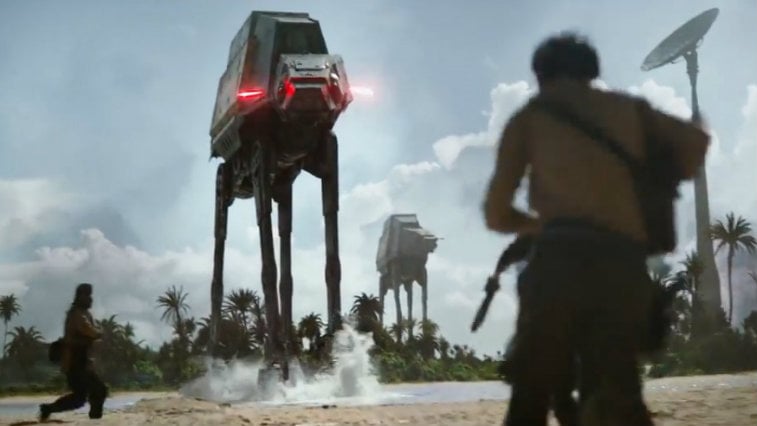‘Star Wars’: The Massive 74-Foot AT-AT Walkers in the Sequel Trilogy Were Actually Small Enough To Hold in Your Hand
The magical special effects seen in Star Wars films are unlike any other. When creating the iconic franchise, George Lucas made sure to invest heavily in the creative direction behind some of Star Wars’ most iconic props, including the spaceships, droids, and the unforgettable lightsabers.
One of the most impressive things about the techniques used to create the special effects seen in the Star Wars films is the level of detail required to render them. Many of the tools involved in the development of the effects were highly complex and demanded a distinguished level of expertise to operate. But there was also a lot of clever trickery used by the art department to give viewers the illusion that objects on-screen were larger and more realistic than they actually were.
The AT-AT destroyer, arguably the Imperial Army’s most menacing ground weapon, was the perfect example of this. Although the destroyers were proclaimed to be over 22 meters tall in the film’s universe, in real life they were actually small models that could fit in the palm of someone’s hand.
The ‘Star Wars’ production crew relied on complex special effects

Many of the scenes depicted in the Star Wars sequel trilogy had never been seen before. Certain props, such as the lightsaber and the Millenium Falcon, were unique to the films and required a very specific touch. Because Lucas was creating a franchise based on such cutting-edge technology, he had to rely on advanced technology to render the visuals he desired.
For instance, a number of the aliens seen interacting in the films were actually plastic figurines that were captured by stop motion photography making incremental movements. The iconic lightsaber was composed of a metal rod, and its signature colored glow was added in post-production. In fact, the lightsaber’s humming sound was actually created by recording a video protector engine and a TV set, according to an interview on the Star Wars Youtube page with sound designer Ben Burtt.
“In the booth where we projected the films, those projectors made a hum…the motors would sit there with this magical, mysterious humming sound… I thought ‘that’s probably what a lightsaber would sound like.’”
The AT-AT Walker was small enough to be carried by hand
In the sequel trilogy, the Imperial Army had a number of terrifying weapons used to battle the Rebel Alliance. From the Star Destroyer to the blaster, they never ran low on tools to oppress the galaxy.
But one weapon in particular literally stood apart from all others. At 22.5 meters (74 feet) tall, the AT-AT Walker was as devastating as it was intimidating. However, although it may come as a surprise, the massive machine portrayed on the big screen was very small in real life. Some models were even tiny enough to fit in the palm of a hand, according to the Star Wars Youtube page.
“The models came in several sizes to match the scale of different live-action shots… It took 9 months to design and build these models… each articulated part of the model must be moved no more than a fraction of an inch between each single frame exposure in stop-motion sequences.”
In order to produce the epic battle sequence shot in what appeared to be an arctic tundra, the team relied on background paintings and “snowscapes” created months afterward, using baking soda and microscopic glass bubbles to generate the “snow.”


